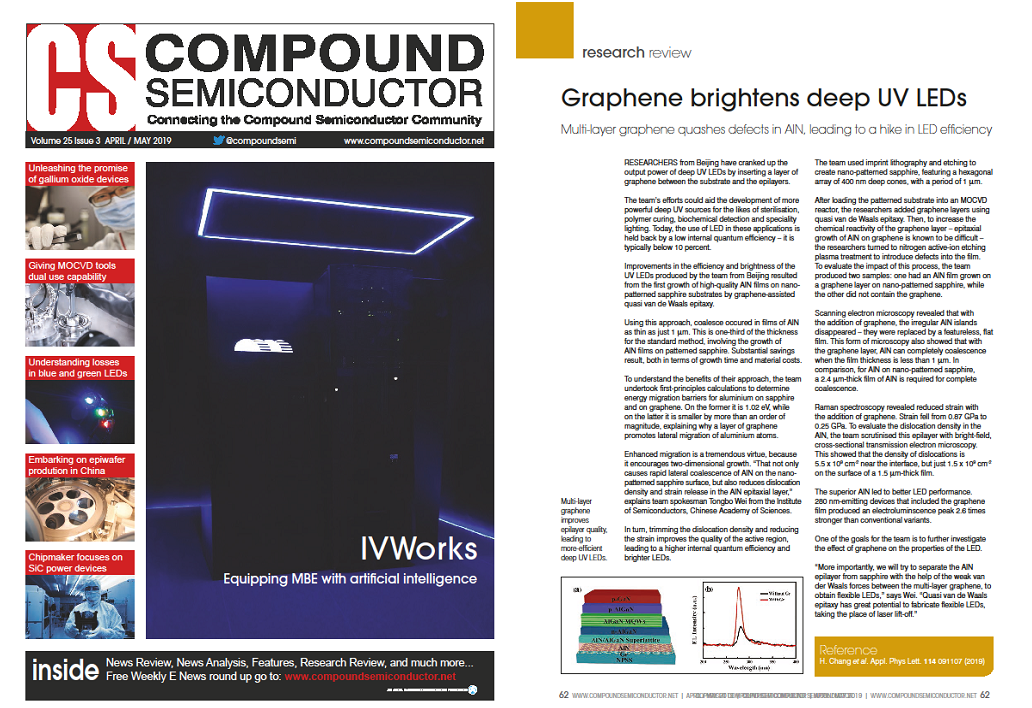Deep-UV LEDs can be widely used in the fields of the disinfection, sterilization, printing and communication. The introduction of the International Minamata Convention has made it even more urgent, However, less than 10% of the external quantum efficiency of commercial deep-UV LEDs severely limits the application of deep-UV LEDs. AlN material quality is one of the core factors of deep ultraviolet LED. AlN films are mainly heteroepitaxially grown on c-sapphire, 6H-SiC and Si (111) substrates by metal organic chemical vapor deposition (MOCVD). There are large lattice mismatch and thermal mismatch between the AlN and the substrate, so that there is a large stress and a high dislocation density in the epitaxial layer, which seriously degrades the device performance. At the same time, AlN precursors have higher migration barriers on such substrates, poor wettability, and are prone to result in three-dimensional island growth. Meanwhile, a biggish thickness is required to coalescence, which increases the growth time cost.
Recently, Lighting Research and Development Center of the Institute of Semiconductors, collaborated to develop a new epitaxial substrate of graphene/sapphire, with the Prof. LIU Zhongfan's team from the nanochemistry Research Center of Peking University and Beijing Graphene Institute. This is a new strategy to promote the growth of AlN films to achieve deep UV LEDs. It is found by DFT calculation that the pyrrole nitrogen introduced into the graphene by plasma pretreatment can effectively promote the nucleation growth of the AlN film. High-quality AlN films are available in a short time with low stress, low dislocation density, and deep UV LED devices exhibit good device performance. This work was published in Adv. Mater., entitled "Improved Epitaxy of AlN Film for Deep-Ultraviolet Light-Emitting Diodes Enabled by Graphene" (DOI: 10.1002/adma. 201807345). Prof. LI Jinmin and Prof. WEI Tongbo from the Institute of Semiconductors and Prof. LIU Zhongfan and Prof. GAO Peng from Peking University are co-corresponding authors of the paper. Dr. CHEN Zhaolong and Prof. LIU Zhiqiang are co-first authors.
Meanwhile, Prof. WEI Tongbo and Prof. LIU Zhongfan's team proposed a growth model of epitaxial AlN on graphene/nano-patterned sapphire substrate (NPSS). Theoretical calculations and experiments verified the enhancement of metal atom migration on graphene surface. Graphene can shorten the merging time of AlN on NPSS by two-thirds, while the deep-UV LED power is significantly improved. It makes deep ultraviolet light source be expected to become a breakthrough in graphene industrialization. The related results were selected as Featured articles after the publication in Appl. Phys. Lett. 114, 091107 (2019), and were specifically reported by AIP Scilight under the title "New AlN film growth conditions enhance emission of deep ultraviolet LEDs". And it has also been reported in the semiconductor industry's two well-known review magazines, Compound Semiconductor magazine (No. 3, 2019) and Semiconductor Today.
In addition, for the international technical problem of p-type doping in deep ultraviolet light-emitting devices, Prof. LIU Zhiqiang proposed a new mechanism of defect-reactive p-type doping which is based on energy band regulation and obtains high-efficiency acceptor ionization rate while maintaining the high hole mobility. The conductivity of p-type gallium nitride of 0.16 Ω·cm is obtained, which lays a foundation for the subsequent application of graphene in the transparent electrode of deep ultraviolet device. The results were published in Semicond. Sci. Technol. 33, 114004 (2018) and won the Best Paper Award for Young Scientists in 2018. The results were also positively evaluated by Prof. Amano, winner of the 2014 Nobel Prize in Physics.
The above series of research works have been supported by the National Key Research and Development Program, the National Natural Science Foundation, and the Beijing Natural Science Fund.

Figure 1 Schematic diagram of AlN nucleation on graphene and results of deep ultraviolet LED devices

Compound semiconductor magazine cover and report page
Article link:
https://onlinelibrary.wiley.com/doi/10.1002/adma.201807345
https://aip.scitation.org/doi/full/10.1063/1.5081112
https://iopscience.iop.org/article/10.1088/1361-6641/aadc01/meta
News link:
https://aip.scitation.org/doi/full/10.1063/1.5097052
